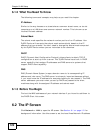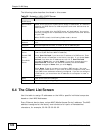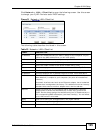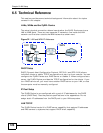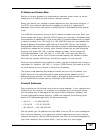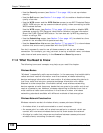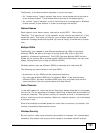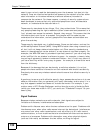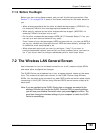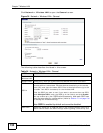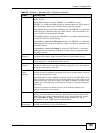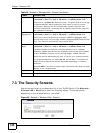
Chapter 7 Wireless LAN
P-2612HNU-Fx User’s Guide
130
•Use the Security screens (see Section 7.3 on page 136) to set up wireless
security.
•Use the QoS screen (see Section 7.4 on page 142) to enable or disable wireless
quality of service.
•Use the WPS screen and the WPS Station screen to use WiFi Protected Setup
(WPS). WPS lets you set up a secure network quickly, when connecting to other
WPS-enabled devices.
Use the WPS screen (see Section 7.5 on page 143) to enable or disable WPS,
generate a security PIN (Personal Identification Number) and see information
about the ZyXEL Device’s WPS status. You can also set up WPS by pressing a
button or using a PIN.
•Use the Scheduling screen (see Section 7.6 on page 145) to schedule a time
period for the wireless LAN to operate each day.
•Use the Association List screen (see Section 7.7 on page 147) to view wireless
stations that are currently associated with the ZyXEL Device.
You don’t necessarily need to use all these screens to set up your wireless
connection. For example, you may just want to set up a network name, a wireless
radio channel and some security in the General and Security screens.
7.1.2 What You Need to Know
The following terms and concepts may help as you read this chapter.
Wireless Basics
“Wireless” is essentially radio communication. In the same way that walkie-talkie
radios send and receive information over the airwaves, wireless networking
devices exchange information with one another. A wireless networking device is
just like a radio that lets your computer exchange information with radios
attached to other computers. Like walkie-talkies, most wireless networking
devices operate at radio frequency bands that are open to the public and do not
require a license to use. However, wireless networking is different from that of
most traditional radio communications in that there a number of wireless
networking standards available with different methods of data encryption.
Wireless Network Construction
Wireless networks consist of wireless clients, access points and bridges.
• A wireless client is a radio connected to a user’s computer.
• An access point is a radio with a wired connection to a network, which can
connect with numerous wireless clients and let them access the network.
• A bridge is a radio that relays communications between access points and
wireless clients, extending a network’s range.



